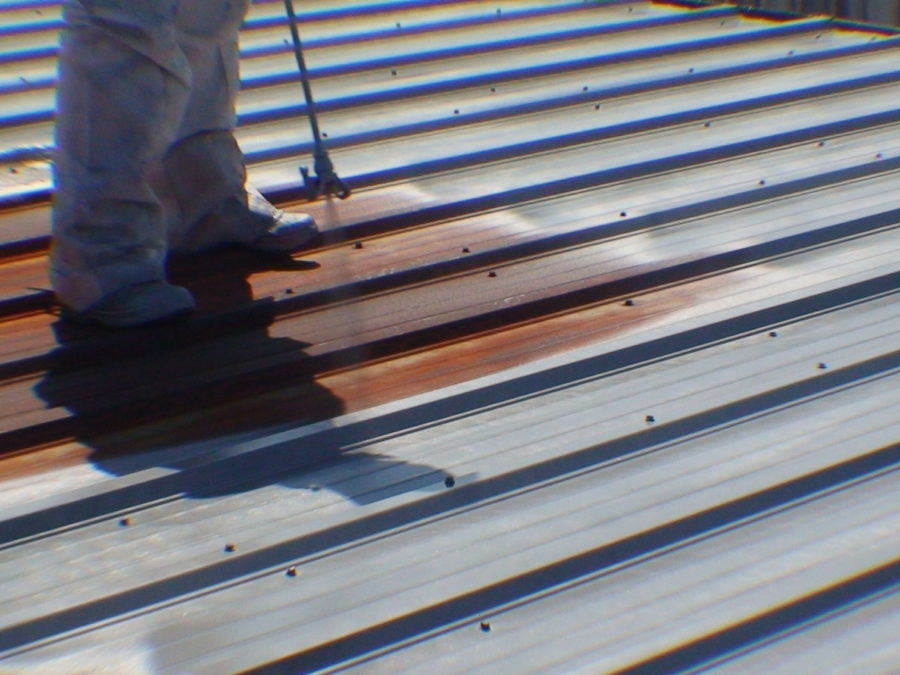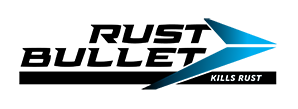Why Rust Bullet® is the Leader in Rust Inhibitive and Protective Coatings
*Coatings are applied to improve surface properties, such as its function, corrosion resistance and wear resistance, and must be a completely continuous film to fulfill its function.*
Rust Bullet, LLC was formed February of 2001 in Reno, Nevada, where our Corporate Offices still operate. The Rust Bullet Products underwent two years of extensive testing before being introduced to the market. We continue to expose our products to new testing in the laboratory and field trials on a regular basis. Rust Bullet’s organization consists of 27 international distributorships, servicing Australia, Europe, Asia, Africa, Middle East, Micronesia, and North America. All Rust Bullet Products are manufactured with the highest quality raw materials available today maintaining strict quality control standards. Environmental Awareness is a key issue in our manufacturing process, and as such, our products contain no lead, no zinc, no chromates, no heavy metals, and pass the EPA Standards for Potable Water as well as the California VOC Standards for a metallic pigmented coating. Rust Bullet has been awarded two patents from the United States Patent and Trademark Office (USPTO). This was the first time the USPTO issued two patents for two new technologies to one rust/corrosion-control product.
To add to Rust Bullet’s already impressive arsenal of labor saving, single component, easy to apply, rust inhibitive and protective coatings, we have recently released Rust Bullet DuraGrade. DuraGrade offers the exceptional performance and protection you expect from Rust Bullet and in addition provides some unique features including significantly reduced VOC content, including Ultra Low VOC. We are working hard every day to bring our consumers products that work and are better for the environment. This innovative new line is not just an old paint formulation with water to replace some of the ingredients then call it Low VOC. Many other companies have chosen to go this route, sacrificing quality. Not at Rust Bullet. We have formulated our Low VOC coatings with new resins and other new ingredients. This new coating technology is a stronger, longer lasting formulation that has ever been seen or used before.
Which Coating is the Right Coating?
Physical integrity of the metal coating is as important as its chemical barrier properties in many applications. Selecting the best metal coating for an application requires evaluating all effects of the specific environment, including thermal and mechanical conditions. Many new materials have been developed, but steel remains the principal construction material for automobiles, appliances, and industrial machinery. Because of steel’s vulnerability to attack by aggressive chemical environments or even from simple atmospheric oxidation, metal coating is necessary to provide various degrees of protection, ranging from hot-dipped and electroplated process to tough polymers and flame-sprayed ceramics. In general, corrosive environments contain more than one active material, and the coating must resist penetration by a combination of oxidizers, solvents, or both. Thus, the best barrier is one that resists “broadband” corrosion. One of the most common and inexpensive protection methods for steel is provided by metal coating with zinc. Zinc-coated, or galvanized, steel is produced by various hot-dipping techniques, but more steel companies today are moving into more environmentally friendly methods of protection.
Rust Bullet is an Environmentally Friendly Product
- Rust Bullet Coatings contain no lead, no zinc, no chromates, & no heavy metals
- Rust Bullet Coatings meet and exceed the EPA Standards for Potable Water
- Rust Bullet Coatings are a mold encapsulate
- Rust Bullet Coatings outperform most fire-retardant coatings
- Rust Bullet Coatings are UV Resistant, chip resistant, scratch resistant & chemical resistant
- Rust Bullet Coatings are a one-step, multiple coat process
- Rust Bullet Coatings properly applied & cured will provide years of unparalleled protection
- The Rust Bullet DuraGrade line of coatings offer Lower VOC content and are VOC compliant in all 50 states.
Satisfied Customers Continuing to use Rust Bullet Products Today
- Federal Aviation Administration, (FAA)
- United States Department of Transportation, (DOT)
- United States Army
- United States Navy (USN)
- United States Air Force (USAF) – Spacelift Range Systems Contract (SLRSC)
- United States Marine Corps (USMC)
- United States Naval Undersea Warfare Centers (NUWC)
- United States Coast Guard (USCG)
- The National Radio Astronomy Observatory’s Very Large Array (VLA) (One of the world’s premier astronomical radio observatories)
Rust Bullet is a Moisture Cure Urethane
Moisture cured means using the natural elements of the atmosphere for curing. This means no artificial heat source is required, no additional activator or component required. Although Rust Bullet Products contain isocyanates, they are not free isocyanates, but rather are safely bound in the polymer chain and pose no health or environmental risk when Rust Bullet is applied according to guidelines as set forth by Rust Bullet, LLC. Rust Bullet is an Aromatic Urethane with Aliphatic Properties
Aliphatic and aromatic coatings differ in the types of polyols and isocyanates used in the formulation, hence their stability in atmospheric conditions differ significantly. Aliphatic coatings are the superior choice for exterior protection because they are very stable when exposed to ultraviolet light, weathering, and hydrolysis. The raw materials used in formulating aliphatic systems are generally more expensive and have a higher viscosities than their aromatic counterparts. Aromatic coatings are more heat and chemical resistant than the aliphatic coatings. Aromatic coatings do not stand up as well against atmospheric exposure since the UV light causes yellowing and chalking.
Because of Rust Bullet’s unique formulation, it is both Aromatic and Aliphatic.
- AROMATIC – Strong, Abrasive resistant, Chemical Resistant, Flexible
- ALIPHATIC – UV Resistant – will not yellow or chalk
Rust Bullet is a Polyurethane Coating Exhibiting Higher Performance than an Elastomeric Coating with Outstanding Flexible Properties
Due to the cross-linking density of a polyurethane coating (short chains and branching) it shows a high degree of chemical and moisture resistance, as well as excellent adhesive properties. These qualities position polyurethane coatings as the best choice in protecting metals from corrosion. As elastomeric coatings do not perform as well in such areas, they are superior in terms of abrasion and impact resistance as well as protection for substrates that demonstrate more movement than metals (such as concrete). Rust Bullet Products have demonstrated a high competition with the elastomeric coatings in that they exhibit an exceptional abrasion resistance (ASTM D-4060), impact resistance (ASTM D-2444) and flexibility (ASTM D-522).
Rust Bullet Coatings Allow for all Exposure Elements
There are three main types of exposure to which coatings are subjected: atmospheric exposure, immersion, and underground exposure. The main difference between atmospheric exposure, immersion, and underground exposure is weather resistance. A coating under atmospheric exposure must endure a variety of conditions, including heating and cooling, oxidation and wetting and drying. Immersion coatings are primarily subjected to water solutions ranging from pure water to high concentrations of various chemicals. Coatings used in underground applications must be resistant to groundwater and soil forces, so they are generally applied thicker than atmospheric or immersion coatings.
Rust Bullet Coatings Provide Optimum Performance in all Three Environments
- Atmospheric – Thermal Stability, UV Resistance, Waterproof, Flexibility
- Immersion – Water Proof, Chemical Resistance
- Underground – Water Proof, Impact Resistance
Rust Bullet Industrial and Automotive Formulas are a 70% (+/- 2%) Solids Product
The high solids in Rust Bullet Coatings means a low content of solvents, which evaporate during curing, therefore more than 70% (+/- 2%) of the product applied to the surface will remain on the surface. This is a more environmentally friendly and safer to use product, with decreased levels of flammability and health risk. Additionally this is a more cost-effective coating with the advantage of additional thickness which helps increase physical properties and chemical resistance.
Rust Bullet Industrial and Automotive Unique Formulas are Stronger than other Aluminum Coatings
Overlapping aluminum flakes add strength and durability as opposed to aluminum powders.
Rust Bullet has Advantages Over and Will Outperform Epoxy Coatings
Rust Bullet is a one part process and the initial coat of Rust Bullet is ready for the second and any required subsequent coats within 2 to 6 hours. Although Rust Bullet does not require a catalyst for curing, Rust Bullet coatings can be made to cure up to 80% faster by using the Rust Bullet Rapid Fire Accelerator. A desired topcoat may be applied within 12 hours after the final coat of Rust Bullet. Full cure time is 72 hours. Epoxy coatings generally take 7 – 10 days to fully cure and allow the solvents to evaporate, some even require force curing.
Due to the exothermic (heat releasing) nature of the reaction during curing of polyurethanes, these coatings can cure at almost any ambient temperature, even during the cold months of the year. Epoxy coatings require temperatures above 50°F.
Rust Bullet Coatings feature a unique “self-inspecting” property in that they fail almost immediately if they are incorrectly applied or if there is a problem with the surface preparation. Thus polyurethane coatings can be inspected immediately after application and any defects in the coating will be visible and can be readily remedied. This is not the case with an epoxy coating that requires an extended curing time and multiple step process for remedy. Breaches in an epoxy coating are labor intensive and will involve a large area outside the breach to be included in the repair. Rust Bullet Coatings rarely experience a breach, but when they do occur, are easily repaired with simple scuffing and application of additional Rust Bullet Product.
The plural components of epoxy coatings require precise mixing ratios be obtained at the point of application to avoid coating defects and failures. This is not an issue with Rust Bullet Coatings as they are a one-part, multiple coat process.
Rust Bullet vs. Polyethylene Coatings
A polymer is a large molecule (macro-molecule) composed of repeating structural units connected by covalent chemical bonds . Polyethylene coatings are produced by filling a pipe with beads of polyethylene and heating until the polyethylene melts and adheres to the pipe interior. Polyethylene is a thermoplastic material which may tend to degrade and become soft when exposed to heat, hence the name thermoplastic. Rust Bullet Products thermal stability is a great asset; 314°F sustained, up to 662°F for up to 72 hours with no visible coating degradation. Additionally the surface burning characteristics of Rust Bullet have proven Rust Bullet will outperform most fire-retardant coatings. Rust Bullet Coatings exhibited a smoke index at 5% and flame spread index at 0% based on the ASTM E84 Surface Burning Characteristics Test.
Rust Bullet Coatings have Superior Adhesive Qualities
Adheres to polished chrome, galvanized surfaces, stainless steel, cold rolled steel, hot rolled steel, fiberglass, to name a just a few.
How Rust Bullet Protects Surfaces
The three recognized methods of protection that coatings provide are; barrier protection, inhibition, and sacrificial action. Barrier Protection blocks moisture, oxygen and other chemicals from the substrate. All coatings are permeable to some degree, but barrier coatings have relatively low moisture permeability. Rust Inhibitive Coatings contain special pigments to inhibit or interfere with the corrosion reactions on the substrate. As moisture passes through the coating film, the anti-corrosive pigments slowly dissolve and aid in stopping corrosion. Sacrificial action is the method used by zinc- and aluminum rich coatings.
- Rust Bullet provides a barrier coating that is non-porous and impermeable
- Rust Bullet contains special pigments and resins that inhibit corrosion
- Rust Bullet Industrial and Automotive Formulas are aluminum rich coatings which will “sacrifice” surface integrity over time saving the substrate to which it has been applied


